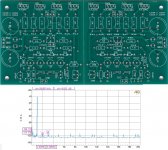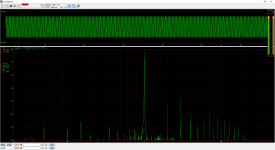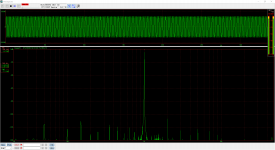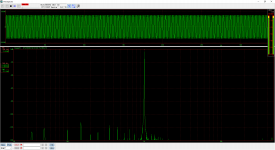With mine i used option n°2.
Yes, more expensive, but you'll be rewarded.
If you will use a PS shunt reg( one for channel), you'll be more rewarded.
Of course it depends on what you are aiming for.
I think that this amp deserves the best PS you can/want afford.
Hope this helps.
P.S. I would throw away option 3.
Thanks that was my thoughts too but wanted some other opinions before I completed the project.
I have a couple of spare psu boards and ripple eaters from dirty pcbs so only need a couple of transformers and an enclosure.
Martin
I see no point in using two transformers or two indepentent PSU to power headphone amp. Costs grow significantly and this "dual mono" or however you may call this configuration brings little improvement. Ground of both channels anyway must be tied at output as stereo headphone jack has common return wire for both channels. One solid regulated and low noise power supply with one transformer would be sufficient. I'm using PSU based on two TL1963A LDOs configured to +/- 15V voltage and amp sounds amazing.
A couple of folks have asked about boards. Restating, they are $3 and have two amplifiers. Shipping varies all over the world. Here is a picture of what they look like:
Hi,
You can charge what ever you wish to cover your time and costs etc. Also, don't you do transistor matching as well and/or sell package of parts??
Which devices were used for your FFT data? Same as in article or different?
THx-Richard
BTW - I dont recommend buying jFETs from EBay etc. Even if "new" because most have been picked thru for matched pairs and then the rest sold. I found the ones from Digi-Key, Mouser etc to be direct from mfr and many matched pairs can be easily found. But when I ordered from eBay, i had a hard time even finding one pair.
-Richard
-Richard
BTW - I dont recommend buying jFETs from EBay etc. Even if "new" because most have been picked thru for matched pairs and then the rest sold. I found the ones from Digi-Key, Mouser etc to be direct from mfr and many matched pairs can be easily found. But when I ordered from eBay, i had a hard time even finding one pair.
-Richard
Thx Richard, that's good to know! I always stayed away from ebay Jfets because of the counterfeit rumors. Just bought 52 BF862s from mouser and 44 of them could be matched within 1% Idss, which is well beyond my expectation...
Hi,
You can charge what ever you wish to cover your time and costs etc. Also, don't you do transistor matching as well and/or sell package of parts??
Which devices were used for your FFT data? Same as in article or different?
THx-Richard
I used the devices from your article. JFET's usually matched to 100uA Idss, 2N's matched for vbe or hfe. the output transistors matched similarly -- MJE's are slightly quieter than 2SD/2SB but the latter have higher gain and show less distortion.
Transistors/diodes for 2 channels $27.50, complete set of parts (no power supply) $54.00. PM if interested.
I have 2 complimentary transistor matchers -- very twitchy.
FWIW, I think I mentioned way back in this thread that even with randomly selected devices the performance is really excellent.
I used the devices from your article. JFET's usually matched to 100uA Idss, 2N's matched for vbe or hfe. the output transistors matched similarly -- MJE's are slightly quieter than 2SD/2SB but the latter have higher gain and show less distortion.
Transistors/diodes for 2 channels $27.50, complete set of parts (no power supply) $54.00. PM if interested.
I have 2 complimentary transistor matchers -- very twitchy.
FWIW, I think I mentioned way back in this thread that even with randomly selected devices the performance is really excellent.
Sent you PM.
I used the devices from your article. JFET's usually matched to 100uA Idss, 2N's matched for vbe or hfe. the output transistors matched similarly -- MJE's are slightly quieter than 2SD/2SB but the latter have higher gain and show less distortion.
Transistors/diodes for 2 channels $27.50, complete set of parts (no power supply) $54.00. PM if interested.
I have 2 complimentary transistor matchers -- very twitchy.
FWIW, I think I mentioned way back in this thread that even with randomly selected devices the performance is really excellent.
Good info.... one more question --- what was the +/- PS dcv used for those tests?
Yes, its mostly the topology which is responsible for the performance but devices and matching do matter also.
THx-Richard
Last edited:
Good info.... one more question --- what was the +/- PS dcv used for those tests?
Yes, its mostly the topology which is responsible for the performance but devices and matching do matter also.
THx-Richard
Twelve volts.
Would be nice if Jan's "Silent Switcher" would put out more current. Gotta talk to him about that!
Some measurements of my amp after a bit playing with trimpots.
1kHz -3dB sine from WaveGene, WaveSpectra 13k FFT Hanning both at 24/96 with ASIO using Creative X-Fi Titanium HD soundcard line out and line in.
First pictrue - 1V RMS, 32R resistive load
Second - 1V RMS, 274R resistive load
Third - 200mV RMS, 274R resistive load
To be honest results looks too good to be real, especially considering my pretty cheap testing gear.
1kHz -3dB sine from WaveGene, WaveSpectra 13k FFT Hanning both at 24/96 with ASIO using Creative X-Fi Titanium HD soundcard line out and line in.
First pictrue - 1V RMS, 32R resistive load
Second - 1V RMS, 274R resistive load
Third - 200mV RMS, 274R resistive load
To be honest results looks too good to be real, especially considering my pretty cheap testing gear.
Attachments
Twelve volts.
Would be nice if Jan's "Silent Switcher" would put out more current. Gotta talk to him about that!
Great! It only gets better at higher PS voltages ----> try +/-18Vdc.??
Thx-Richard
Some measurements of my amp after a bit playing with trimpots.
1kHz -3dB sine from WaveGene, WaveSpectra 13k FFT Hanning both at 24/96 with ASIO using Creative X-Fi Titanium HD soundcard line out and line in.
First pictrue - 1V RMS, 32R resistive load
Second - 1V RMS, 274R resistive load
Third - 200mV RMS, 274R resistive load
To be honest results looks too good to be real, especially considering my pretty cheap testing gear.
Looks about right --- with your test equipment, you can finely trim values for absolute lowest distortion.
Also, what are your PS voltage used for your results?
THx-Richard
Last edited:
TL1963A PSU is configured for about ±15V. My main headphones are 250 ohms Beyerdynamic DT990 Pro so trimming was done at similar load. DC offset is less than 2mV at both channels. I'm using transistors matched by Jack so output devices are Hitachi rather On Semi.
OK Thx... helps others to know how you got to the results you have....
BTW -- how does it sound?
-Richard
Amplifier sounds amazing. I'm not best at describing sound but I can say it is very natural. Rich, beautiful midrange. High frequerencies with lots of details while not being too sharp. Bass is deep and well controlled. The stage is wide.
THx for the feedback. Your results are like the others reported here.
Now, just enjoy the music.
-Richard
I bought this article ages ago and am about to finally start building it. I have some questions that an hour of reading hasn't answered  :
:
If I wanted to lower the gain, I increase R8 right? What value would you recommend for half the present gain of 12?
Are there any recommended current-manufacture alternatives for the output BJTs? Or are the ones specified in the original article still the best option? And if different devices are preferable do they still need the full3-diode string?
What power rating do the various resistors need? Is a full 1W needed for the output BJT resistors?
Assuming large enough heatsinks, increasing bias is a good thing right? Any recommendations here?
Thank your an excellent article Dr Marsh!
If I wanted to lower the gain, I increase R8 right? What value would you recommend for half the present gain of 12?
Are there any recommended current-manufacture alternatives for the output BJTs? Or are the ones specified in the original article still the best option? And if different devices are preferable do they still need the full3-diode string?
What power rating do the various resistors need? Is a full 1W needed for the output BJT resistors?
Assuming large enough heatsinks, increasing bias is a good thing right? Any recommendations here?
Thank your an excellent article Dr Marsh!
Last edited:
- Home
- Amplifiers
- Headphone Systems
- Marsh headphone amp from Linear Audio



